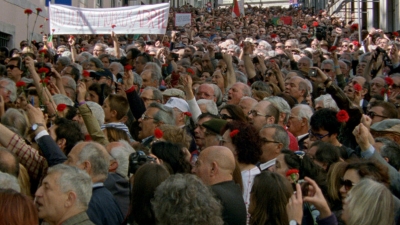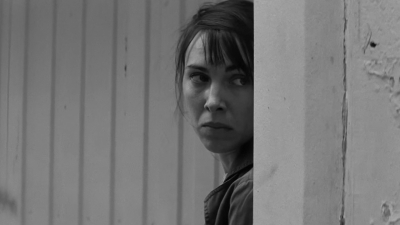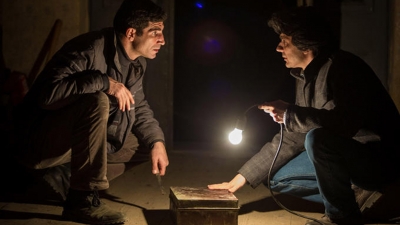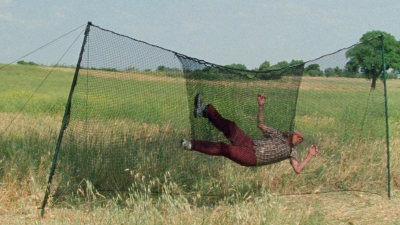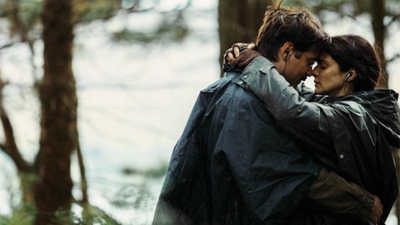"If I think about the future of cinema as art, I shiver" (Y. Ozu, 1959)
SPECIALE - SUPERCANNES 2015
Le mille e una notte, al giorno d’oggi, in Europa
Davide Oberto
“Oh re fortunato e felice, si racconta che in un triste paese tra i paesi, dove si sognano di balene e sirene, la disoccupazione si espande. In certe zone la foresta brucia la notte nonostante la pioggia e in altre uomini e donne fremono d’impazienza per tuffarsi nell’oceano in pieno inverno. A volte gli animali parlano, benché sia improbabile che qualcuno li ascolti. In questo paese, in cui le cose non sono quelle sembrano essere, gli uomini di potere si spostano cavalcando cammelli e nascondono permanenti e vergognose erezioni, nell’attesa che arrivi il momento della raccolta delle tasse per poter pagare lo stregone che...”
Così Sherazade comincia a raccontare le sue storie al sovrano in As Mil e Uma Noites Vol.1 – O Inquieto di Miguel Gomes. Il “triste paese” di cui si narra è il Portogallo, “triste paese tra i paesi” d’Europa, capo/testa d’Europa, ma anche appendice, estremità, confine di un continente che è stato a sua volta caput mundi, ma che forse non è altro che estrema propaggine dell’Asia. O, forse, solo propaggine fallica di uomini potenti e senza controllo che viaggiano su cammelli...
Il 20 maggio del 1990 Jacques Derrida tenne una conferenza a Torino dal titolo “L’altro capo – Memorie, risposte, responsabilità”, nell’ambito di un convegno che si proponeva di ragionare su “L’identità culturale europea”. Derrida, ispirato da alcuni testi di Paul Valéry, scritti nell’imminenza della Seconda Guerra Mondiale, cercava di descrivere un’Europa in cui da poco era caduto il muro di Berlino, in cui si agitavano ancora confuse perestrojke, in cui il capitalismo occidentale sembrava trionfare e la storia sembrava finire, nell’imminenza di possibili razzismi, nazionalismi e diseguaglianze sempre maggiori.
25 anni dopo, sugli schermi di Cannes, al giorno d’oggi, un regista portoghese si agita, inquieto, durante le riprese del suo film: vuole raccontare la dismissione dei cantieri navali di Viana do Castelo e, insieme, la storia di un McGyver locale che riesce a sconfiggere un’invasione di vespe.
In effetti As Mil e Uma Noites comincia così, con il regista/capo che scappa, cerca di sfuggire alla capitale questione del racconto che vuole essere militante e insieme fantastico, e, affascinato dalla propria locura, ha paura di non poterla sostenere e di non riuscire a raccontare l’oggi d'Europa, nell’imminenza di una crisi sempre nuova che inquieta senza sosta e senza soluzione.
Il capo (del film) lascia spazio non a un altro capo, ma all’altro del capo, che anche Derrida cercava nel suo breve testo come antidoto a un’identità culturale europea che allora rischiava di chiudersi e che, al giorno d’oggi, si è chiusa nella retorica di linguaggi tanto trasparenti, quanto uniformanti, e violenti nell’esclusione e nella decisione.
L’altro del capo è Sherazade che cercherà di incantare il sovrano, l’uomo potente in erezione perenne, con storie infinite, liberando la forma del cinema dalla necessità di essere riconosciuta, incasellata, neutralizzata (vedi la paura di Fremaux, direttore del Festival di Cannes, burocrate della cultura europea che temeva Derrida, di fronte a questo geste de cinéma da anestetizzare in fretta). La locura di immaginarsi un film in cui le vespe convivono con i cantieri, in cui il reale diventa fantastico e le balene sputano sirene, in cui un gallo parla e un giudice lo ascolta, è la locura che solo può creare una cultura (e un cinema) che sappia essere sempre diversa da se stessa, inclassificabile, sempre critica, responsabile, per lasciarsi trasportare ancora da Derrida, della possibilità dell’impossibile.
Al giorno d'oggi, in Europa.
Between dream and nightmare
Boris Nelepo
Hobbling nurse Jen without delay singles out a sleeping soldier who looks just like Clark Kent, Superman's alter ego. His superpower is being able to smell the flowers he sees in his dreams - some skill for a military man. If it were up to him, Itt the soldier would rather sell mooncakes than wash the generals' cars. But, what is a Thai filmmaker to do when last year's coup, his country's twelfth in 80 years, leaves him petrified with fear and despondency? Apichatpong Weerasethakul doesn't want to show weapons or bloodshed or suffering on screen; nor does he know how. Though an articulate political statement, his Cemetery of Splendour also relates a tale of impossible love reminiscent of Jean-Claude Brisseau's The Girl from Nowhere, weaving a dream chronicle into a childhood memoir.
Here director revisits his hometown of Khon Kaen, for which he longed in Chicago while working on his short 011664322509 and where the autobiographical Syndromes and a Century was partially set. The visionary auteur often uses the expression “the burden of memory”. On his journey northeast, he circles around the locations of Uncle Boonmee..., whose characters referred to some "brutal hunt for communists." In Blissfully Yours, a character points to the jungle and says, "This is where the ghosts of Japanese soldiers dwell." The goddesses in Cemetery tell Jen outright that the earth beneath her feet is strewn with corpses.
The past holds people hostage. A portrait of General Sarit Thanarat, who was instrumental in the 1947 coup and staged the insurgences of 1957-58, now oversees the soldiers in the canteen. As it pans across town Apichatpong’s camera comes to a halt at a militarist low relief also dedicated to Thanarat. Unlike Joe's earlier vistas of mellow moods, Cemetery of Splendour appears shot through with currents of anxiety, disquiet, and paranoia. In one of the film's recognizable leitmotifs, the characters treat each other with continual mistrust, suspecting some clandestine identity in everyone: is he a terrorist, police spy, FBI agent? Jen suddenly remembers that her ex-husband was in the army, too - and a veritable monster he was. His name turns out to be Colonel Narong. A biographical detail from the actress's life, but at the same time Colonel Narong, a member of the “Three Tyrants” that seized the power in the 1960s, did exist. “When you’re asleep your metabolism slows down. Someday you’ll see a better future,” Jen promises Itt.
A dissolve - an image from one scene transitioning slowly into the next - is perhaps the most apt word to describe Cemetery. A former school is transformed, temporarily, into a hospital. In the movie’s climax, Keng the medium channels the spirit of Itt who lies asleep and thus evidently suggests a metaphor for the acting profession, even though the audience for this performance consists of Jen alone. It’s worth noting that the part of Itt went to the same actor who had played soldier Keng in Tropical Malady, so the medium in the new movie quite literally becomes the old Keng. When in the medium’s body, Itt takes Jen for a walk through the woods showing her an imaginary reality that includes a king’s throne room, a music room, a room of mirrors, and pink marble. The dissolve technique is deployed to great effect in the giddy scene at a movie theater, where Apichatpong captures in an uninterrupted take five escalators moving in different directions; slowly, the images of soldiers dozing in a hospital seep through onto the screen. The ward we see now is equipped with bizarre, downright fantastic tubes constantly changing color.
This color therapy is supposed to chase away nightmares. Jen professes her love for Itt as she only knows how: “When you’re asleep even the bright city lights look boring.” At some point Jen wants to wake up, and Itt instructs her to open her eyes as wide as she can. In the very last - and most disquieting - shot, she sits in front of a furrowed football field, children playing among holes, and tries her best to open her eyes. However, the hardest part is to draw the line between a dream and a nightmare.
Dead-ends
Giona A. Nazzaro
Amidst the totally over-the-top full-blown non-stop action galore, there lies hidden at the core of Fury Road an almost theoretical film about the complexities of the transformations that cinema has gone through in the past few decades. If much is to be applauded in Miller's choice about going analogic in the realm of post post-modern digital action cinema, then maybe his critical discourse and proposition can even more be appreciated. Strip everything away from Fury Road and you are left with an almost abstract film. What once would have been labelled as an "avantgarde" film. First of all, the main character. The film title plays with the notion that it is the very same Mad Max of the first three films. But then, again, and without diving in the fandom conspiracy theories, there's really nothing in the film to substantiate this claim. So: Max is not Max after all. Who is he then? The guy called Max, aptly identified as a "bloodbag" (even though he protests a different identity), is literally the narrative blood that keeps the film flowing. The audience keeps their eyes on him and the film moves. So "that" guy carries the fuel blueprint of the film as precisely as Monica Vitti carried the hyperdynamic stillness of Michelangelo Antonioni's L'avventura on her body and in her gaze. And if the characters in Antonioni's films about alienation and anonimity in modern European architectural lanscapes didn't have anywhere to go, so does Max. With some differences, though. The urban lanscape has been substituted with a desertic nowhere land which, of course, over the years has become a commonplace and popular symbol of the failure of capitalistic society. But Miller expands on the basic idea with a wonderful ironic footnote. Given that there is no need for another hero, and that after Joyce and Eliot heroes have become something completely different altogether, Miller gives his Max with no name at least two different options: you can go either forward or backward. History has not only repeated itself enough already, it has definitely exhausted itself. So what is left of adventure and action? Not much. You can go either forward or backward. That is what's left of the great spectacle that once was cinema. Space has become a two-lane road on which you can re-stage the great spectacle of repetition; replay all the former stories that have already been re-told over and over again in different industrial manners. While Antonioni staged the end of the western world as the end of the possibilities given to culture to shape or reshape ways of communicating, Miller, in a very ironical way, creates the "überstage" for the definitive image of what western culture has become as seen through the lenses of that very cinema which imagined itself, in Griffith's work, as an extension of the Dickensian ethos. Fury Road, really, is the swan song, maybe the sublime, while also earnest, parody of all the dead-ends that contemporary cinema has taken.
As Eliot has it in his Nocturne
Blood looks effective on the moonlit ground -
The hero smiles; in my best mode oblique
A foreign body against the greens, yellows and browns
James Lattimer
Although Arabian Nights is a work of perpetual interpolation, it’s the second volume that celebrates both the pleasure and pain of insertion, for when one thing is put into another, some things change, but others do not. Perhaps that’s what makes The Desolate One so affecting, the slow, aching realisation that however joyful the insertion, it will still be swallowed up by reality sooner or later. Even where there is blood, there will later be pragmatism.
Clad in red, rangy fugitive Simão always feels like a foreign body against the greens, yellows and browns of the Portuguese landscape, despite his best efforts to blend in. At one point, he does indeed vanish into the vista behind him, only to frustratingly reappear shortly afterwards. As Simão roves this austere realm, a string of absurdities is inserted into his wanderings: a donkey dragging Miguel Gomes’ bloodied corpse, a trio of nubile women who offer all the trimmings, a pedalo for pottering across a lake. But all this absurdity comes to nothing in the impassive setting, drowned out by the relentless buzzing of insects, the roar of the wind, the sound of birdsong. It’s no surprise when the landscape finally expels Simão too, his capture as implacable as the air, the rocks and the sun or the lone poplar visible from his cell.
A principled judge must preside over a straightforward matter, the case of a desperate woman driven to sell her landlord’s possessions. Everyday life in a Portugal gripped by austerity, even if this nocturnal assembly is held in an ancient amphitheatre and not all its attendees are human. As the judge probes further, the circle of the implicated only widens: a runaway cow, a yelping pack of unrepentant thieves, a put-upon genie, a mournful olive tree. Yet all these gleeful injections of fantasy fall silent in the face of reality, each happy flight of fancy wrenched back down to earth by another true-life detail of Portuguese suffering. And it’s inevitably one final insertion that brings tears to the judge’s eyes, a note placed in a wallet to replace the money it held, a dignified apology for a theft whose only culprit is the situation itself.
Somewhere among the trees, mist and herds of sheep, there lies a housing estate whose inhabitants are uncommonly sad, grown weary of evictions, rusted-up lifts and the air currents that circulate between the blocks. Yet one day, a mysterious newcomer arrives to lift the gloom, a quiet marvel in the form of a white dog named Dixie. His is a truly beneficent presence which does indeed spread joy, offering comfort to the desperate and uniting the marginalised. But tragedy is an unstoppable force, for even inserting such a perfect machine for loving into this cruel world cannot change its essential nature. Maybe that’s why Dixie must also be a machine for forgetting, shutting out the misery around him so as to continue his mission, the only thing able to confound him being the sheer miracle of his own spectral presence.
Fra l’essere stati e non essere più
Daniela Turco
“Durante le riprese di Liberté la nuit, pensavo che tutti gli antifascismi, gli atteggiamenti politici fossero necessariamente generati da rapporti intimi forti tra le persone. Ciò che può modificare veramente la storia, è che una persona trovi, credendo all’amore, l’energia per sradicare questa o quella ingiustizia. Era questo che volevo raccontare, i rapporti tra la vita privata e la storia”.(P. Garrel, Les Inrockuptibles, 1991).
Davanti a L’Ombre des femmes, si scopre ancora una volta che il cinema di Philippe Garrel si apre su luoghi - le stanze spoglie degli appartamenti, le strade solitarie e gli scorci dei caffè di Parigi, ma anche, più semplicemente, i volti stessi - radicalmente sfuggenti a un’identificazione temporale precisa, in quanto a emergere, invece, è la presenza astratta e tuttavia organica di una costellazione interiore, dove, a rendersi visibile, insieme alla concretezza dei corpi - un vibrante “teatro della pelle” di lezione dreyeriana - è il disegno essenziale dei sentimenti che, percorrendoli internamente, li scuotono e li rivelano. Pochi altri registi come Garrel si sono avventurati a dare questa consistenza - corpo e immagine - alla rivelazione abbagliante di paesaggi interni, discontinui e inesplorati, dove solo la psicoanalisi, o l’amore, riescono a entrare, semplicemente affidandosi all’idea che “il cinema sia un lavoro manuale che si fa con l'inconscio”.
La coppia Masculin/Feminin, è il nodo godardiano e il laboratorio sensibile da cui Garrel parte sempre; in L’Ombre des femmes, sono Manon e Pierre che condividono la vita e un lavoro di cineasti indipendenti, che contribuisce allo squadernarsi, come se fosse sfuggito a una piega del tempo, di un intero repertorio di oggetti fantasmatici, oggi sotto reale minaccia di scomparsa definitiva, gli strumenti del cinema, come il tavolo di montaggio, o le ‘pizze’ che contengono le pellicole di repertorio nell’archivio dove Pierre incontra l’ altra, Elisabeth, la giovane stagista che vi lavora e con cui avvia una relazione. E se è ancora vero che la potenza del cinema è quella di sostituire allo sguardo un mondo che si accorda ai nostri desideri, allora quel bianco e nero dolcemente dilatato nello scope, che freme e sfugge come fanno del resto l’amore e la vita - quindi il cinema -, magistralmente modulato da Renato Berta, può restituire, per alchimia, ben più di un mondo, dentro quelle stanze, su per le scale, dentro i letti sfatti, nella complice penombra dei caffè, fino a risvegliare con tenerezza crudele l’intera stagione della Nouvelle Vague, di cui Garrel è figlio, per risalire, anche più oltre, fino al sorgere aurorale delle prime visioni Lumière, di cui si fa portatore di tracce e di memoria sensibile.
Verità e menzogna, esistenza e desiderio, memoria e storia di una relazione privata che si riflette come in uno specchio, ponendosi direttamente in relazione con la Storia, forse mai come in L’Ombre des femmes, Garrel ha voluto dare al suo lavoro così tenacemente antiborghese la nettezza di un segno preciso, mostrando, molto più che dimostrando, come il personale sia sempre politico.
Raccontati, a tratti, dalla presenza romanzesca di una voce off (non a caso quella di suo figlio, Louis Garrel), che rivelandoli, ne continua a proteggere l’ombra – l’inconscio - , Manon e Pierre possono ritrovarsi nell’intensità fragile di un abbraccio dopo il funerale del falso eroe della Resistenza che avevano filmato per mesi, per scoprire, alla fine, che non aveva raccontato loro che bugie. Impercettibile oscillazione vertiginosa, qui, come già in J’entends plus la guitare, tra l’essere eroi (héros), l’essere felici (heureux) o semplicemente, ancora una volta, tra l’essere stati e non essere più.
À corps perdu
Emilie Bujès
C’est sous la houlette de Robin des Bois que semble être placé Le Trésor (Comoara), le dernier opus du réalisateur roumain Corneliu Porumboiu. Costi, son protagoniste principal, y évoque en effet dès la scène d’ouverture le brigand au grand cœur à son jeune fils, avant de lui lire le soir venu le récit de ses aventures. Scène de vie quotidienne contemporaine dans une famille de Bucarest.
Mais déjà le film prend une autre tournure, puisqu’un voisin convainc Costi de l’existence d’un trésor dissimulé par son arrière grand-père dans la propriété familiale - intéressante question que celle de la propriété; celle-là même qui sous-tend également la lutte de Robin des Bois. Les problèmes économiques du voisin, engendrés en partie par la crise, s’entrelacent dès lors à une histoire improbable dans laquelle Costi s’élance à corps perdu, bien davantage pour ce qu’elle représente que pour ses implications financières potentielles.
Inspiré d’une expérience similaire - à l’issue moins favorable - vécue par Porumboiu, Le Trésor s’articule autour d’un fil narratif aussi gracile que délicieusement subtil. Sur un sol, investi d’Histoire(s) - la Révolution roumaine de 1848, la période communiste et ses implications économiques individuelles, notamment en ce qui concerne l’expropriation, et le post-communisme - la partie centrale du film, composée de longs plans et séquences, rend compte de la quête d’apparence pour le moins désespérée, de trois hommes à la recherche d’un trésor enfoui. A un certain hyperréalisme, ponctué sans cesse de hiatus insolites, répond alors une dimension largement plus absurde qui s’adosse à cette temporalité venant bousculer le rythme du film, et à des éléments au comique naturel, tel l’homme au détecteur de métaux, sonore.
Difficile désormais de ne pas attendre ou redouter un renversement de situation, un retour brutal au réel. Mais l’enjeu est ailleurs pour Porumboiu, qui en passant revisite la critique institutionnelle dans une scène avec des policiers, non sans rappeler son Policier, adjectif (déjà lauréat du Prix du Jury de la sélection Un Certain Regard en 2009) : l’utopie du quotidien, l’utopie au quotidien; rien de moins.
C’est alors sans surprise et avec délectation que l’on parvient à la scène finale (attention, spoiler): Costi, refusant la déception de son fils face à l’apparence prosaïque du trésor, se procure dans une bijouterie un butin digne de l’imagination d’un enfant. Après que la caméra lentement eut balayé la place de jeux et ménagé une séquence aussi décadente que jouissive dans laquelle les bambins se disputent joyeusement les bijoux, ne reste que le soleil. Et bientôt résonne «Life is Life» repris par Laibach, qui vient envelopper tout le film d’une tonalité nouvelle.
Encantamiento en colectivo
Gonzalo de Pedro Amatria
Hay pájaros, muchos pájaros en la tercera y última parte de la trilogía que Miguel Gomes presentó en la Quincena de Realizadores del Festival de Cannes, bajo el título de As mil e uma noites. Hay muchos pájaros en una película que no es solo la tercera parte de una trilogía, que no es un resumen de las otras dos, sino una propuesta cinematográfica en sí misma. Y quizás la más libre de una trilogía que reivindica de forma evidente la locura, la libertad, el error, el disparate, y el goce, el ecantamiento, frente a la grisura, la tristeza, la formalidad y las políticas económicas sustentadas en el dolor ajeno. Hay muchos pájaros, y la metáfora podría ser fácil, y también errónea: los pájaros son esos animales fáciles de leer en clave simbólica como imágenes de la libertad, el escape, el vuelo libre y sin amo. Pero Gomes, encantador inteligente, no cae en la trampa fácil de la metáfora barata, y lo que propone en este tercer volúmen, llamado así O Encantado, es un encantamiento colectivo para conjurar los embates del mal: uno, dos, tres. Hipnotizados.
La gran parte de esta película, casi cincuenta minutos, es un documental hipnótico, un ejercicio de prestidigitación cinematográfica dedicado a retratar con detalle el trabajo aparentemente absurdo de una comunidad de los arrabales de una ciudad portuguesa dedicada a una tarea invisible y secreta: la captura de pinzones para educarlos posteriormente en cantos antiguos que recuperan de viejas grabaciones, o que recomponen pacientemente en rudimentarios equipos informáticos. Una tarea a la que dedican su vida entera por el mero hecho de practicarla: por la belleza, y no por el rendimiento, por el goce, y no por el dinero, por la memoria, por el tiempo disfrutado, por la poesía, los cantos, los pájaros. Un documental, inserto con total naturalidad en una película que no es ficción, pero tampoco documental, sino un compendio de todo lo posible y lo imposible, que no es solo el retrato de un ejercicio de resistencia, de puesta en práctica de la belleza frente a un mundo azotado por las sombras del paro, la crisis y los recortes, sino un ejemplo de que el cine político puede encontrar caminos insondables. En los pájaros, por ejemplo, que hipnotizan al espectador con sus cantos casi constantes durante 45 minutos, creando ese encantamiento del que habla el título: un espacio de resistencia, un acto de amor por lo mínimo, por aquello que no tiene valor de cambio, no genera plusvalía, no es monetizable, y por tanto, es imposible de recortar o contabilizar. En aquello que además se realiza en colectivo. Como cantaba el movimiento 15M en España, que inauguró una nueva concepción de lo común en la poliica: “Nos quieren en soledad, nos tendrán en común”. Así, la película reivindica lo colectivo, lo grupal, la vivencia en sociedad de que quizás no es real, pero tampoco imaginado. Como el propio Gomes reconocía en una entrevista con Mark Peranson, “In all the film we spend our time trying to organize this battle between the imaginary and reality - what belongs to Portugal, and what belongs to the tale of Scheherazade”. ¿Y a quién le importa la respuesta? Con su equilibrio entre lo documental y lo imaginario, entre los cuentos de Sherezade, a la que vemos cantar, gozar, bailar, huir, beber, amar, y los cuentos extraídos de la realidad de un país al que quería arrasado, en soledad, Gomes entra de lleno en esa categoría que Paul Ward denomina “lo irreal”: “The ‘irreal’ does not simply refer to something that is ‘not real’ but is a distinction between objective reality on the one hand and outright fantasy on the other. The irreal is distinguished from both of these by virtue of being a recognizable reality that does not literally exist in the objective world ‘out there’, but might be said to be (hypothetically) derived from it”. Nos tendrán en común. Encantados. O cantando, contando cuentos, silbando, bailando. Durante mil y una noches.
Animali pazzi
Lorenzo Esposito
Il set come luogo del delitto. Menzogna che, in quanto tale, introduce l’immagine alla verità, proposta però come ferita non rimarginabile. Falso movimento, anzi proprio falsificazione – attraverso procedure che slittano ambiguamente fra ironia e cinismo – dell’atto stesso del vedere.
Questo, fino a ieri, è stato Yorgos Lanthimos. Ora però The Lobster sembra voler spostare l’idea di realtà come primo livello dell’assurdo che ci circonda direttamente sul piano narrativo. Non è solo l’escamotage della voce fuori campo, talmente onnisciente, che, come si capirà poi, parla da un futuro non ben identificato, già slittato oltre l’ultima enigmatica inquadratura. Piuttosto è una sorta di inatteso romanticismo, di placida e avventurosa rifinitura del racconto, che offre libertà e insieme compattezza al vortice fatto di rabbia e aggressività e ironica cerebralità del nonsense cui è solito il regista greco.
In fondo The Lobster non è altro che una bellissima love story. Che tuttavia nasce in un mondo disseccato, depredato, prosciugato di sentimenti, dove l’amore o è costrizione sociale o è semplicemente vietato: in entrambi i casi la base fondante di uno stato di polizia reale e inconscio. Certo che è difficile credere al vero amore, soprattutto se si teorizza una basilare crudeltà dei rapporti umani, ma non è detto che per questo sia necessario ritirarsi in solitudine, o al contrario cacciarsi l’un l’altro fino a morire, o addirittura rinunciare a combattere e decidere di venire trasformati in un animale. Se ti sfregano il culo addosso tutte le mattine, è giusto che il tuo cazzo esploda. Se è vietato parlare d’amore, è tuttavia probabile che un bacio simulato si trasformi in vera danza di lingue.
Ma è davvero tutto così ambiguamente in autentico? La cosa affascinante, e tutt’ora misteriosa, del cinema di Lanthimos è che quanto più spinge sull’esibizione del falso, risultando talvolta anche a rischio di auto-falsificazione, tanto più risulta non programmatico e istintivo. Gli attori per esempio, famosi o meno che siano: è così evidente il modo in cui Lanthimos se ne tenga a distanza, in modo da ottenere dei corpi nella loro pura brutalità, non certo l’auto-analisi cosciente del personaggio (che di solito è dei brutti film).
Allo stesso modo, limitarsi banalmente a segnalare come caratteristiche dei suoi film, e di questo in particolare, bizzarria e tensione distopica (peraltro, come si è visto, del tutto ininfluenti anche rispetto al mero contenuto, veri e propri specchietti per le allodole per lobotomizzati da tappeti rossi e montées de marches), significa eludere quella sorta di selvaggio smarrimento che resta il punto filmico su cui si svolge la visione che Lanthimos ha del mondo: una terra colpita da cecità universale, che corre inebetita verso il vuoto, già metafora di se stessa, senza speranze. E dove l’immagine, giocando sul bordo di questa frattura insanabile, usa i corpi come mezzi estremi di una fuoriuscita possibile.
Ultimi articoli pubblicati
- 2025-03-24 Chime/Cloud/Serpent’s Path (Kurosawa Kiyoshi)
- 2025-03-24 Abiding Nowhere (Tsai Ming-liang)
- 2025-03-24 The Box Man (Gakuryū Ishii)
- 2025-03-24 Grand Tour (Miguel Gomes)

